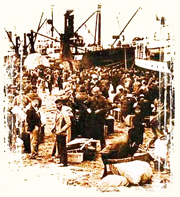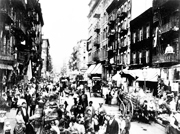New York was born in South West Manhattan. That's where a ship carrying a hundred Dutch immigrants arrived to what would become New Amsterdam. It was May, 1623. The Mayflower and its Puritans had been in Massachusetts for about three years by then.
But New Amsterdam had a different purpose -- these Dutch immigrants imprinted a commercial personality to the settlement that would not be easy to delete. Not even when the British fought for New Amsterdam in 1664 for the Duke of York and named it after him.

Unlike other ignominious cases throughout America, where battles against Native Americans and colonialists resulted in a largely unnecessary bloodbath, the colonization of New York was significantly uneventful. The manhattanite Algonquian and Iroquian tribes showed no hostility when they saw funnily-dressed foreigners arrive with no purpose of leaving.
Officially, they sold the now most-coveted piece of land on Earth for 24 dollars. But actually, neither the Algonquians nor the Iroquians had no concept of ownership in their culture. They thought the sale process was just a twinning ceremony (seeing as both the Algonquians and Iroquians belonged to the Lenape group of kindred tribes, they were used to sharing what they had).
In a way they were not wrong: the natives were never thrown of out town and pretty much co-existed with the colonists. Generations later, they could be seen in the streets and in the bars, just like any other New Yorker.
Dutch New York's limits don't differ too much from the ones it has today. There was a small slave colony where the United Nations headquarters now stand. Turtle Bay (which has always been remarkably turtle-free) was back then Deutel Bay (the English mispronunciation of the name accounts to the subsequent confusion). Harlem was called Nieuw Haarlem. What we now know as The Bronx was a farm that belonged to a Scandinavian immigrant called Jonas Bronck. And so on.
Wall Street also had its origins in this era. The eponymous wall was built at the eleventh hour as a barricade to keep the British invaders off. It never had much work to do. The city was bloodlessly conquered by the British when a Peter Stuveysant, New York's last Dutch mayor, surrendered along with his people. He then resumed life on his farm.

Right above Wall Street, where streets like Lafayette and Mulberry now stand, there once was a swampy area with a substantial pond full of fresh water. The Dutch called it Kalchoock. The British aptly called it Fresh Water Pond. The name evolved into the even more succinct Collect Pond. It was the city's lung. It can still be seen by those willing to go down the area's sewers.
Back then social activity was intense in Collect. It was where families went for weekend picnics. The pond was rich in fish, so people gathered at its shores to haul out and chat for a while. European fishing habits, however, must have looked really unproductive to proto-New Yorkers because by 1732, a law had to be passed forbidding the use of nets to catch fish in order to prevent the survival of the pond's fauna.
There was an island in the waters of Collect, in which the African Americans that participated in the Slave Insurrection of 1741 were hanged, beaten, burned or dislocated. Public hangings would take place on it for there on in.
Up until the 1800's, New Yorkers would live off the waters of Collect pond and its subterranean water springs. After the 1800's, they used it to carefully deposit a mountainous amount of garbage.
You see, around that time a number of tanneries, breweries, ropewalks, and slaughterhouses were built in the shores of the pond. Upon their arrival, its waters were pristine. Afterwards, not so much. In 1802, the city determined to drain Collect pond to end the stench and diseases emanating from it. A few years later, permission was granted to build on the drained area -- even if its salubriousness was arguable at best.
Buildings were nonetheless promptly erected in the swampy terrain -- and promptly sunk. Only one solid construction stood -- the Coulter brewery. Which was converted to an apartment building. A big building with a lot of tiny, unstable apartments, that is.
It wasn't the healthiest of places to be living in. But that didn't stop tiny streets and unstable wooden houses with smelly basements to slowly rise around it. The Collect took in the people that weren't welcome anywhere else.
It became a haven of outlaws, immigrants and prostitutes. It became the source of endless fascination of such notable pens as Charles Dickens and Walt Whitman.
It became, in other words, Five Points.